A
Auto Express
Guest
Verdict
With the ID.3 catering for hatchback buyers and focused on Europe, the ID.4 SUV is Volkswagen’s first serious global Tesla rival. It represents an impressive yet different alternative to the longer range, flashier Model Y with its anticipated higher price tag. When entry level ID.4 models begin to hit the market next year buyers will be offered a stylish and straightforward electric SUV with a fair price tag. It’s no-frills electric family motoring, and we like that.
Welcome to the Volkswagen ID.4 - a seismic follow up to the ID.3 hatchback. That’s because, while the ID.3 is the Golf’s electric brother, the ID.4 is essentially an all-electric alternative for the brand’s best selling model - the Tiguan.
At 4,580mm in length it sits in between the Tiguan and the Tiguan Allspace for size. UK specifications aren’t yet finalised but in Europe there are ten pre-configured models, including the 1st Edition car driven here. There’s a higher spec 1st Edition Max model, but our car makes do with 20-inch wheels, full LED headlights, automatic climate control, a rear-view camera, parking sensors at both ends and heated seats. There’s also satellite navigation linked to a 10-inch central touchscreen, and fully digital instrumentation.
- SEE MORE Best electric cars to buy 2020/2021
The ID.4 1st Edition is priced from €49,950 in Germany before any incentives - around £46,000. Throw-in the UK government grant and that places it closer to £43,000. It means that the high-spec launch versions of the ID.4 eclipse the very top end of the newly facelifted Tiguan line-up, though the new Tiguan eHybrid plug-in and Tiguan R models have not yet been priced in Britain.
The broad line-up planned for the ID.4 means the starting price will drop into the low-mid £30,000s when entry level versions arrive. That means it’ll achieve price parity with mid to high spec versions of its popular petrol and diesel powered sibling.
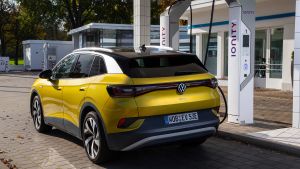
image
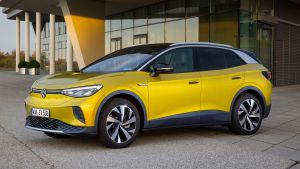
image

image
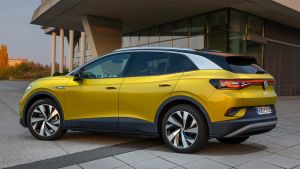
image
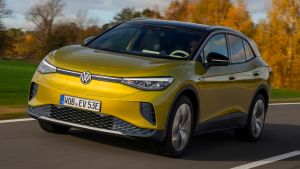
image
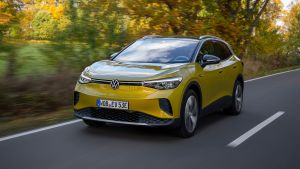
image

image
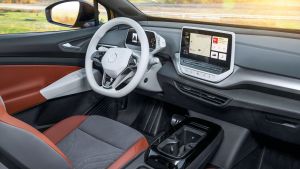
image
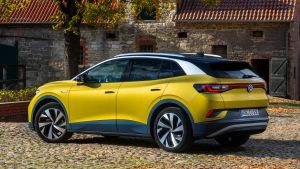
image
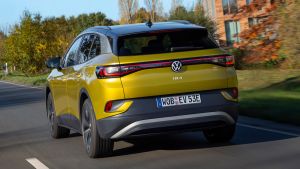
image
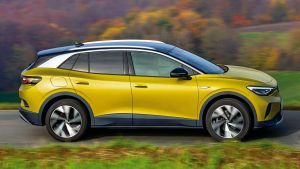
image
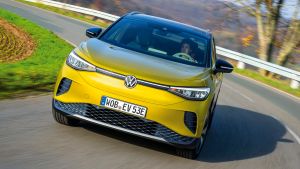
image
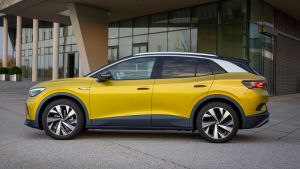
image
A tall driving position and easy access: that is what buyers like about SUVs. With the ID.4, there’s another key ergonomic benefit as there is no centre-tunnel. You sit elevated in the back for excellent visibility. Feet and legs are as free as you like with acres of space, but the surprising height of the rear seats means taller back seat passengers may want a bit more headroom.
As for boot space, Volkswagen claims 543 litres. That’s a strong showing, upping the level of space in the back of the regular Tiguan, and expanding to 1,575 litres with the rear bench folded flat.
You can see and feel where the ID.4 steps up in quality over the ID.3. While the hatchback is primarily aimed at Europe, this car will certainly be sold in the US, so better interior quality is in demand. The door panels feel softer from halfway up and some plastics on the dashboard are nicer, but from the B-pillar onward it gets cheaper, and unfortunately anything you touch below the dashboard feels a little hard and scratchy as well.
One huge technological advance is the arrival of the impressive augmented reality head-up-display, artificially projecting information and navigation commands straight onto your view of the road ahead. It’s the best system of its kind this side of the latest Mercedes S-Class, but is a pricey option.
The ID.4 1st Edition has a 201bhp/310Nm electric motor driving the rear wheels and a large 77 kWh battery; the smaller battery of 52 kWh will also be used later in combination with 146 or 168bhp motors.

image

image

image

image

image

image

image

image

image

image

image

image

image
With the 77kWh battery it gets a 324-mile range according to WLTP standards - not a bad figure at all, and realistically you’ll get around 250 miles with little effort. Recharging tech is solid enough too - it charges at 125 kW. Find a suitable roadside plug and theoretically, after 30 minutes, 198 miles worth of charge goes into the battery. An 11kW on-board charger is also standard on the 1st Edition, for use with a home wallbox or a charging point at work.
You don't drive ID.4 for super-sharp handling - it weighs-in at over 2.1 tonnes, thanks mainly to the near 500kg battery. Some 30 years ago this would have been around two VW Golfs in mass. However, this SUV is fun to drive. It zips off the line with decent acceleration, taking 8.5 seconds to reach 62mph, but then tailing off to a relatively slow top speed of just 99mph.
It rides nicely too, disguising the weight of the hefty drivetrain with almost magic qualities that can be put down to the optional electronically controlled dampers. Around town a turning circle of 10.2 metres is impressive for a car of this size.
While you can feel the mass in the way the ID.4 builds speed, in the corners you don’t really notice the huge weight - it’s surprisingly agile and links nicely with the light and accurate controls. It’s a textbook EV and will serve as a good demonstration to diesel and petrol family SUV buyers as to what the all-electric fuss is about. With simple driving modes and braking regeneration settings to flick through too, it’s very easy to get on with.
| Model: | Volkswagen ID.4 1st Edition |
| Price: | £43,000 (est inc picg) |
| Engine: | 77kw battery, 150kW electric motor |
| Power/torque: | 201bhp/310Nm |
| Transmission: | Single-speed automatic, rear-wheel drive |
| 0-62mph: | 8.5 seconds |
| Top speed: | 99mph |
| Range: | 324 miles (WLTP) |
| CO2: | 0g/km |
| On sale: | Early 2021 |
Continue reading...
